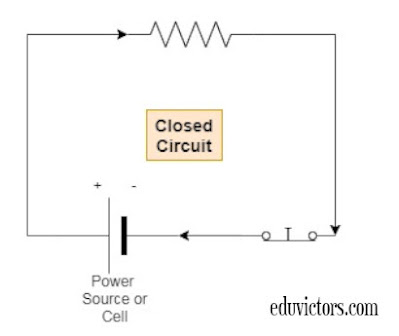Class 10 Physics - Electricity - Open Circuit vs Closed Circuit vs Short Circuit
Open Circuit
An open circuit implies that the two points are externally disconnected, which is equivalent to a resistance R = ∞ . This means that theoretically no current(I = 0) can flow between the two terminals, regardless of any value of potential difference ( V= 0 to ∞).
In an open circuit, current does not flow due to incomplete path. It is represented by ‘( )’ in an electric circuit. The potential difference measured between two terminals will be zero.
Closed Circuit
A closed-circuit makes a complete path and allow flow of electric current continually. In an electric closed circuit, current flow from positive charge to the negative charge particles.
It is represented by ‘( . )’ in an electric circuit. In closed circuit, the potential difference exists between the two terminals of the closed circuit.
Switch
A device designed to open or close a circuit under controlled conditions is called a switch.
Note: Very high voltages can cause arcs of current to flow even over large air or vacuum gaps!
Short Circuit
A short circuit implies that the two terminals(points) are externally connected with resistance R= 0, the same as an ideal wire. This means there is zero voltage difference(V=0) for any value of current (I=0 to ∞) flowing through it.
In AC circuit, when live wire comes in direct contact with neutral wire accidentally. Resistance becomes zero and it results in flow of large amount of current beyond the capacity of the conductor (overloading).
Use in Practical Measurement
An ideal voltmeter is an open circuit. An open circuit is a limiting approximation for a real voltmeter, which will have some large (but not infinite) resistance.
An ideal ammeter is a short circuit. A short circuit is a limiting approximation for a real ammeter, which will have some small (but not zero) resistance.
Practically, a short circuit is a low resistance connection in parallel to other circuit elements(Resistance/cell).
In the diagram above (short-circuit), the resistance is short circuited by using a connecting wire C (a less resistance path almost zero ohms) and hence current pass through it, than the resistor of a high resistive path.
👉See Also:
Ch 12 - Electricity (Q & A, NCERT Solutions and Numerical)
Ch 12 - Electricity (MCQs-1)
Ch 12 - Electricity (Worksheet)
Ch 12 - Electricity (Important Points To Remember)
Ch 12 - Electricity (Holiday Assignment)
Ch 12 - Electricity (Assignment)
Ch 12 - Electricity (Very Short Question Answers)
Ch 12 - Electricity (MCQs-2)




No comments:
Post a Comment
We love to hear your thoughts about this post!
Note: only a member of this blog may post a comment.